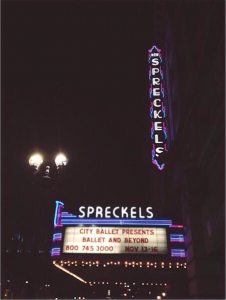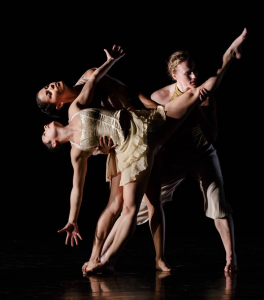Go! City Ballet, Malashock Dance, SD Dance Theater on One Gorgeous Stage
 City Ballet of San Diego has always presented generous programs—Act II of “Swan Lake” along with three other dances, all-Balanchine shows in which they tackle the master’s most rigorous work. But the company goes even farther with “Ballet and Beyond,” which opened last night and runs through Sunday afternoon. City Ballet invited San Diego’s two top modern dance companies, Jean Isaacs San Diego Dance Theater and Malashock Dance, to share the beautiful Spreckels Theater stage with them. It’s glorious to see work by Isaacs and Malashock at the Spreckels, described by one visiting international company as an ideal stage for dance.
City Ballet of San Diego has always presented generous programs—Act II of “Swan Lake” along with three other dances, all-Balanchine shows in which they tackle the master’s most rigorous work. But the company goes even farther with “Ballet and Beyond,” which opened last night and runs through Sunday afternoon. City Ballet invited San Diego’s two top modern dance companies, Jean Isaacs San Diego Dance Theater and Malashock Dance, to share the beautiful Spreckels Theater stage with them. It’s glorious to see work by Isaacs and Malashock at the Spreckels, described by one visiting international company as an ideal stage for dance.
And the generosity doesn’t stop there. There are two unique programs, eight dances in all. Program A opened last night and repeats Saturday; Program B runs tonight and Sunday afternoon. Both programs offer one dance each by City Ballet’s Elizabeth Wistrich and Geoff Gonzalez, Malashock, and Isaacs. The pieces by Gonzalez, a dazzling up-and-comer, are premieres. Also premiering, on Program B, is a thrillingly ambitious work from Wistrich—”A Life According to Me,” with a story and book by John Nettles, director of the City Ballet Orchestra and sets from the San Diego Opera; and Nettles, along with two other singer/actors, will be onstage, and the City Ballet Orchestra will perform live.
 Whether through design or happy accident, both Isaacs’ and Malashock’s pieces on Program A are ethereal. The program opens with Isaacs’ “O Magnum Mysterium,” to contemporary choral music by Ola Gjeilo. Ten dancers in drapey off-white or beige garb might be angelic beings or flocking doves. Playing with constriction and release, they squeeze in their limbs and then expand. They group tightly in one corner, but then, as a “Kyrie” swells, break into exultant movements that fill the stage. As a central couple, Trystan Loucado and Erica Ruse do tender partnering. And in an exquisite final image, everyone seems to jump for joy.
Whether through design or happy accident, both Isaacs’ and Malashock’s pieces on Program A are ethereal. The program opens with Isaacs’ “O Magnum Mysterium,” to contemporary choral music by Ola Gjeilo. Ten dancers in drapey off-white or beige garb might be angelic beings or flocking doves. Playing with constriction and release, they squeeze in their limbs and then expand. They group tightly in one corner, but then, as a “Kyrie” swells, break into exultant movements that fill the stage. As a central couple, Trystan Loucado and Erica Ruse do tender partnering. And in an exquisite final image, everyone seems to jump for joy.
Isaacs initially showed “O Magnum Mysterium” as part of Trolley Dances (two years ago? the program doesn’t say) in the lobby of the Monarch School, with live choral music, and, though I missed the live music, the recording she uses is superb, and it’s a delight to see this piece on the Spreckels stage.
Malashock’s “Great Day” also premiered (last April) with live music, the Art of Elan chamber ensemble playing Judd Greenstein’s “At the end of a really great day.” The recorded version used here isn’t studio-quality—there’s some screeching when the flute hits high notes—but that’s my one negative about this playful, lilting, wistful dance, one of Malashock’s best-ever. Like gleeful kids, the five dancers do pony-like trots and giddy spins, especially the three women. The men’s play turns to a bit of rough-housing, Justin Viernes and Nicholas Strasburg doing chest-bumps and acrobatics, but it’s all in fun.
The choreographic invention includes folk dance-style lines and lifts where the two men hold a woman aloft (Stephanie Harvey does mid-air splits). The mood is carefree, but moments when Heather Glabe wanders off alone hint at the poignant story behind the music: a young woman Greenstein knew was killed in an accident, and at a memorial, someone said, “She died at the end of a really great day.”
Wistrich reprised her 2013 premiere, “C-Squared,” with its dramatic set, three massive metal X’s designed by Dale Stokes. Angular choreography echoes the geometric set, and the spare steel-gray, black, and bronze costumes (designed by Tamlin Henahan) create the impression of dancing metal. This is a challenging piece to perform, with sustained balances and limited musical cues—whether in long stretches of silence or in the modernist Charles Wuorinen score—and the dancers handle it splendidly. Often, though, the piece drags, and I found it more admirable than entertaining.
The program’s premiere came from the new kid on the choreographic block, Gonzalez. His “Speakeasy,” is set in a gin joint whose patrons manage to pull off tight pirouettes and jazzy hip thrusts despite looking wasted, the women with disheveled hair and the men staggering. Couples pair up, but warily, and don’t ultimately connect—not even Jessie Mowes and Adam Bloodgood, whose pas de deux takes its acrobatic lifts from ballet but its fierce attitude from Apache Dancing. And Rony Lenis—a company apprentice whom I predict will be promoted soon—has a Broadway flair as the guy who’s all alone after the bar closes, doing high capers from side to side. (I could picture Lenis in a Jerome Robbins ballet.)
Gonzalez, a rising star, seems to have no trouble managing a 14-person cast. And his solid instincts extend to his music choice—he plays against the romanticism but finds the undercurrent of tension in a Rachmaninoff score.
His arrival, among the established talents of Isaacs, Malashock, and Wistrich, is just one of the reasons I can’t wait to go back to the Spreckels tonight for Program B.

Award-winning dance journalist Janice Steinberg has published more than 400 articles in the San Diego Union-Tribune, Dance Magazine, the Los Angeles Times, and elsewhere. She was a 2004 New York Times-National Endowment for the Arts fellow at the Institute for Dance Criticism and has taught dance criticism at San Diego State University. She is also a novelist, author of The Tin Horse (Random House, 2013). For why she’s passionate about dance, see this article on her web site, The Tin Horse
